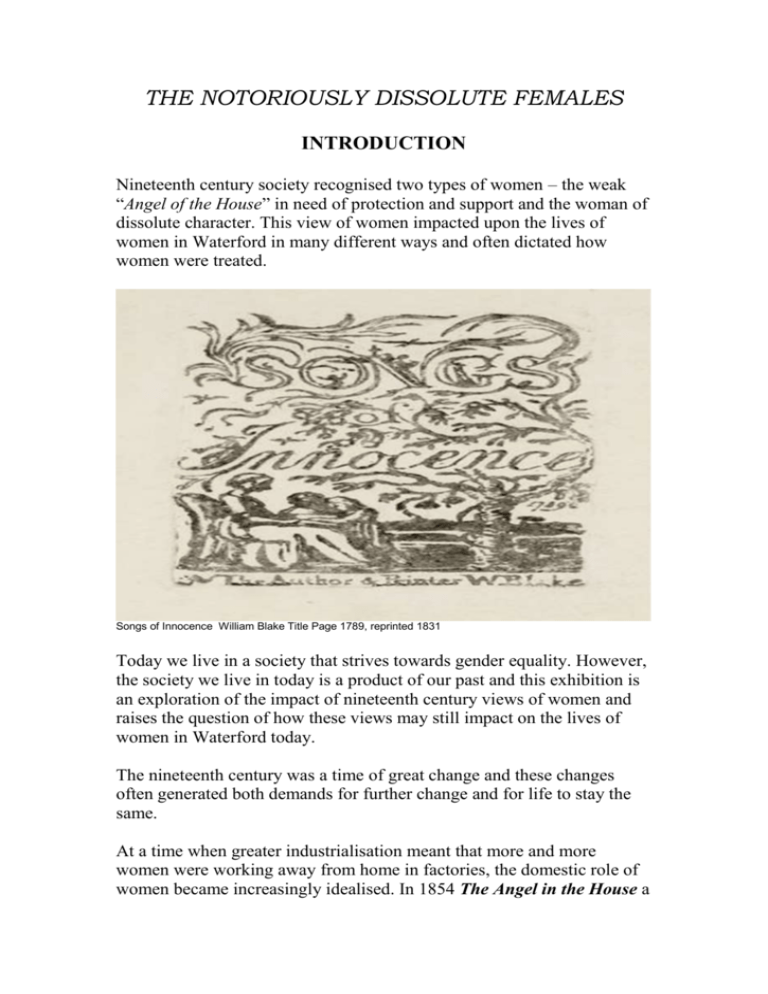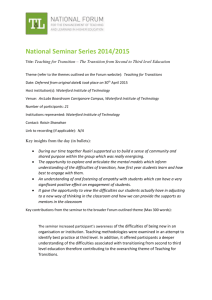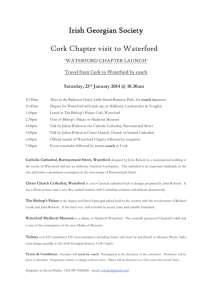women and poverty - Waterford City and County Council
advertisement

THE NOTORIOUSLY DISSOLUTE FEMALES INTRODUCTION Nineteenth century society recognised two types of women – the weak “Angel of the House” in need of protection and support and the woman of dissolute character. This view of women impacted upon the lives of women in Waterford in many different ways and often dictated how women were treated. Songs of Innocence William Blake Title Page 1789, reprinted 1831 Today we live in a society that strives towards gender equality. However, the society we live in today is a product of our past and this exhibition is an exploration of the impact of nineteenth century views of women and raises the question of how these views may still impact on the lives of women in Waterford today. The nineteenth century was a time of great change and these changes often generated both demands for further change and for life to stay the same. At a time when greater industrialisation meant that more and more women were working away from home in factories, the domestic role of women became increasingly idealised. In 1854 The Angel in the House a poem by Coventry Patmore was published extolling the virtues of a woman devoted to her husband and meek in all things. Man must be pleased; but him to please is women’s pleasure; down the gulf Of his condoled necessities She casts her best, she flings herself. How often flings for nought, and yokes Her heart of an icicle or whim, Whose each impatient word provokes Another, not from her but him; While she, too gentle even to force His penitence by kind replies, Waits by, expecting his remorse, With pardon in her pitying eyes; And if he once, by shame oppress’d, A comfortable word confers, She leans and weeps against his breast. And seems to think the sin was hers; Or any eye to see her charms, At any time she’s still his wife, Dearly devoted to his arms; She loves with love that cannot tire; And when, ah woe, she loves alone, Through passionate duty love springs higher, As grass grows taller round a stone Interestingly, today books such as The Surrendered Wife by Laura Doyle are re-visiting the idea that Man must be pleased; but him to please is Woman’s pleasure. Unidentified Family. Image Courtesy of Waterford County Museum THE NOTORIOUSLY DISSOLUTE FEMALES THOSE UNFORTUNATE FEMALES Women as Angels were considered the moral guardians of society but this role carried with it the responsibility for any lapse in morality. A number of efforts were made in the nineteenth century to control the spread of venereal disease. This was a particular concern of the military, given the spread of the disease among young men throughout their ranks. British Military at Grattan Square, Dungarvan. Image Courtesy of Waterford County Museum Prostitution was often a feature of garrison towns where a large supply of custom could be found among the young men stationed there. Dungarvan in County Waterford was a garrison town and on 24 th September 1877 the Dungarvan Town Commissioners: Resolved, that our attention having been called by the inhabitants of Bridge Street to the state in which the street is kept by being made the resort of prostitutes whose conduct is such that the inhabitants have to remove from the front rooms of their houses to the rear so as to avoid hearing the fearful expressions of those unfortunate females, we request the attention of the Constabulary to the removal of such a fearful state of the locality DUDC/1/5 In response to the spread of venereal diseases the government introduced between 1864 and 1869 the Contagious Diseases Acts. These gave the authorities the right to declare any women living in certain garrison towns prostitutes and forcibly examine them for venereal disease. The authorities continued to look towards the treatment of women in the prevention of the spread of venereal disease and in 1918 re-affirmed this policy in Regulation 40d Defence of the Realm Act (DORA) which prompted the Irish Women’s Franchise League to protest vehemently against the introduction of the compulsory medical examination of women which they felt was an attempt to: “make vice safe for men…and is…an outrage against the liberty, honour and integrity of every woman and as a deliberate attempt to perpetrate the evil double moral standard” WCC/GNA/92 THE DISSOLUTE FEMALE Given the weak nature of the Angel in the House it was believed that women should be protected from their fallen sisters – the dissolute. Adam and Eve – Women by nature potentially dissolute The Boards of Guardians responsible for running the Workhouses in the County were careful to ensure that the dissolute women would not mix with the virtuous poor. Resolved. That a classification of the female Inmates being deemed necessary so as to separate the notoriously dissolute females from those whose misfortunes compelled them to become inmates of the House – a portion of the Workhouse be allotted to their use to be called “The Dissolute Ward” LISMORE UNION 1852 BG/LISM/11 Dissolute Characters – Master submitted a list of the Wet Nurses now in the House, having illegitimate children with the view of the Guardians selecting from amongst them those to be placed in the Dissolute Ward DUNGARVAN UNION 1855 BG/DUNGN/ The Dissolute Wards of the Workhouses housed, in particular, unmarried mothers and prostitutes. On the 17th January 1856 the Dungarvan Board of Guardians resolved that: …Anne Sullivan and Bridget Curreen – prostitutes; admitted this day be sent to the Dissolute Ward The price women paid for being regarded as Dissolute can be seen in the courts. On 28 July 1841 the Waterford Mirror newspaper reported on the Waterford Assizes where the Hon. Baron Pennefather and the Hon. Justice Torrens, Judges of the Leinster Circuit arrived to hear the Assizes. The newspaper reported on the direction of the Judge who said: There were only 3 cases requiring any particular attention, which were offences against females. They ought accurately to examine the evidence in these cases and not find the bills if, they had any serious doubt – he meant that all cases should be accurately examined into, but these cases particularly so. This concern on the part of the Judge is clarified by the newspaper which provides the information that “The prosecutrix was a woman of uneasy virtue…”. The Awakening Conscience by William Holman Hunt 1853 These views of the place of women in society appear in all aspects of life in the nineteenth century and can be seen in how women were treated in poverty, in poor health and in violence. WOMEN AND POVERTY Women were not considered capable of controlling their finances and properties and as a result they were particularly vulnerable to poverty in the past in Waterford. Until the first Married Women’s Property Act of 1870 a husband could take legal control of all of his wife’s properties and she had no right to property she herself may have inherited or indeed purchased. Further, until the introduction of the Matrimonial Causes Act, 1857 a legally separated wife did not have the right to keep what she earned and her husband could return at any point in time, take any money she earned, and leave her again. In Waterford the impact of this control of properties and monies held by a husband over his wife’s interest can be seen in the case brought by Richard Chearnley, esquire against Andrew English. Richard Chearnley enquired of a barrister whether Andrew English could be compelled to pay his wife Susan (Chearnley’s aunt) an annuity (annual sum of money), which had been left to her by her father in his will. In response the barrister stated that Andrew English was his wife’s “paymaster” and could not be compelled by the trustees to pay the arrears of annuity due to his wife. The vulnerability of women to poverty can be seen in the Minute Books of the Boards of Guardians for the Workhouses throughout Waterford. These records show a consistently higher number of able-bodied females than males in the Workhouses. Taking the years 1855-1858 and samples from different Workhouses throughout the County there is a clear indication that women were far more likely to enter the workhouse than men. Workhouse Dungarvan Date 29 September 1855 24 November 1855 26 January 1856 Kilmacthomas 7 July 1855 24 November 1855 Able-Bodied Females 65 Able-Bodied Males 29 83 36 184 84 106 60 13 16 Volume Code BG/DUNGN/13 BG/KILTHOM/6 Lismore Waterford 10 January 1857 27 June 1857 19 September 1857 27 March 1858 19 June 1858 18 September 1858 66 23 69 18 53 14 353 130 300 114 240 93 BG/LISM/20 BG/WTFD/20 In many cases, the men of the family remained outside the Workhouse looking for work, often leaving the country and their families behind them. BG/LISM/31 11 April 1868 The Board admitted the wife and 2 children of a man named Michael Brien of Deerpark, the family living in a state of utter destitution though the man could not be induced to enter the Workhouse BG/LISM/31 The Boards of Guardians kept a close watch on this practice and pursued any men they believed to have abandoned their family while he himself was earning money that could be paid for their keep. BG/LISM/31 Today women are not quite as vulnerable to poverty, according to the EU Survey on Income and Living Conditions of 2005 from the Central Statistics Office which reported that “While females were found to have a higher risk of poverty than males in 2004, there was little or no observable difference in 2005”. However, the same survey also found that consistent poverty was higher among females than males. Women in rural areas could generate money by participating in cottage industries. With the advent of factory- produced goods in the nineteenth century this source of income was not as readily available and families had to either do without this income or do without the women who worked in the factories. People entering the Workhouse had no means of support at all and no possibility of being able to support themselves. If it was discovered that there was any means at all or possibility of any means of support then they would be discharged from the Workhouse. BG/DUNGN/57 On 28 February 1857 a member of the Board of Guardians in Lismore made the following notice of motion: Notice that on Wednesday next the 11th inst. I will move that all ablebodied women in the Work House not having more than 2 children be discharged from the House On 7th March 1857 the Board discussed this motion with the following clarification: The Board having received information from the Guardians of the several Electoral Divisions to which they belong that the following paupers could find employment at once if discharged from the Workhouse A vote was then held and passed by 8 votes to 3 that a list of women whose names were supplied by the Master would be discharged to find employment. It was only on the further resolution of a board member that the Relieving Officer was directed to “…make full enquiry as to the probability of the parties named in the list proposed by the Master being able to get employment in the event of their being discharged from the Work House and that he do attend the Board with such Report at the meeting of the Committee” On 14th March 1857 the Committee having received the report of the Relieving Officer recommended the following to be discharged from the Workhouse Bridget Grady and 1 child Cathe Barry and 1 child Mary Geary and 1 child Mary Flynn and 1 child Eliza Connell Mary Carthy Jane Kepple and 1 child (To remain in House until May next) Nancy Mulcahy and 1 child (when latter is well) Mary Anne Cunningham Today, unemployment payments can be withdrawn if: You refuse a suitable job offer including Community Employment or a suitable FÁS course While living in the Workhouse “inmates” (as they were known) were not allowed to generate any income at all, they wore the clothes of the Workhouse and had to apply to the Board for a suit of clothes if they ever managed to get a position and leave the Workhouse. ‘Bridget Dunn’ and ‘Mary Reardon’ were reprimanded in 1862 for “clandestinely knitting stockings” and their materials forfeited so any attempts to generate income or indeed clothing beyond that supplied by the Workhouse were prevented. BG/DUNGN/27 BG/LISM/31 Today, it is possible to work for a stated number of days for a stated maximum income while still allowing for claims of Jobseekers Benefit or Allowance. Within the Workhouses women were kept busy, where possible. Report of the Visiting Committee to Waterford Union 5th April 1859 The exercising ground of the Unmarried mothers and their children is always in a more or less dirty state, slops are still frequently thrown on the grass instead of into the sink, which was settled in my last report, some months ago. I think it would be better, and more wholesome if it were all gravelled. The women are I fear not sufficiently employed, at Industrial work. The numbers in that Department are alarming BG/WATFD/22 Women often worked in the wards of the Fever Hospital. Hospitals were often staffed by prostitutes and the poorest of women as it was considered a very menial job and it was not until after the Crimean War (1854-1856) and the work of Florence Nightingale that efforts were made to establish a qualified nursing profession. For some time the hospital wards and care for the sick remained the duty of the lowest in society – the women of illrepute. WOMEN AND HEALTH Poor health is closely associated with poverty and poor living conditions are a major cause of illness. In the nineteenth century many people suffered from lung infections and other illnesses associated with the damp and cold living conditions they endured. The Labourers (Ireland) Acts of the 1880s onwards were introduced to provide better quality housing for the labouring classes. The Boards of Guardians implemented this public housing scheme and they were responsible for choosing the tenants of the houses built under their direction. On 19 April 1888 the Dungarvan Board of Guardians made the following resolution Resolved that no Labourers Cottage be let to a woman in this Union BG/DUNGN/59 Dungarvan Board of Guardians, 1901. Image Courtesy of Waterford County Museum It would appear from this resolution that women in Waterford did not have the same access to housing as men. They were dependant on a husband or male family member to provide a home. Today, Waterford County Council provides public housing based on a Housing Needs Assessment that does not take into account the gender of applicants. However, women did have access to medical services. The Medical Charities Act, 1851 provided medical attention to more people, in particular, to those unable to pay for the services of a doctor themselves. Under this Act the Poor Law Unions were divided into districts and each district had a doctor in attendance with a dispensary stocked with medicine and medical appliances. As this system developed a network of dispensaries provided healthcare throughout the County and patients who visited the dispensary doctor could be given tickets to attend the Fever Hospital for further treatment and on the recommendation of the Medical Officer patients from the Fever Hospital could be sent for specialist treatment to other medical institutions. BG/WATFD/152 BG/DUNGN/27 BG/WATFD/20 On 7 April 1869 (BG/LISM/31) the Lismore Board of Guardians heard the following report: A woman named Ellen Walsh 52 years of age was admitted to the Infirmary on Monday about 12 o’clock suffering from Influenza, and she died next morning about 2 o’clock. She was brought to the Workhouse in the van from Cappoquin Dispensary and she was very cold as she had no covering on her and little straw under her. The Master suggests that it would be desirable to procure a mattress and bolster for the van for weak and sickly persons sent to the Workhouse. The Medical Officer was sent for on her admission and he saw her immediately and had everything done for her that her case required. Women as carers for children were often responsible for visiting the dispensary doctor and as a result were often more likely to avail of medical services than men. Today, according to Women’s Health in Europe: Facts and Figures Across Europe women remain more likely than men to come into contact with health care professionals and to use their services. Unidentified Woman and Boy Image Courtesy of Waterford County Museum. In addition to providing a doctor the dispensary system also included the services of a midwife for each Dispensary District. The nineteenth century saw a number of advances in relation to childbirth, in particular, chloroform began to be used for pain relief in childbirth. Initially, the idea of a pain-free labour was objected to by religious traditionalists who believed that mothers should fulfil what they believed to be the edict of God to “bring forth children in sorrow”. The use of anaesthesia in childbirth received a great boost of support when it was used by Queen Victoria in 1853. BG/LISM/32 However, childbirth still remained very dangerous and there are numerous entries referring to “dangerous midwifery”, in the Board of Guardians Minute Books: 15 December 1869 In compliance with a requisition from Dr. Luther, Cappoquin Dispensary he procured the services of Dr. Flynn of Dungarvan to assist him in a dangerous midwifery case on the 10th inst…Dr. Luther was in attendance upon a Dispensary Ticket Dr. Flynn’s fee is 2 guineas BG/LISM/32 BG/LISM/64 The advent of greater medical attention at childbirth was initially more of a hindrance than a help until it was realised that women giving birth in the more hygienic conditions kept by convents and nursing hospitals were more likely to survive than those in hospitals being treated by doctors who failed to wash either their hands or instruments as they went between patients. The discovery of germs and a greater understanding of contagion improved the rates of survival greatly. BG/WATFD/152 WOMEN AND VIOLENCE Women as dependants on a husband or male relative were as a result dependant upon the goodwill of that male authority figure. In 1840 a judge upheld a man’s right to lock up his wife and beat her in moderation. During the nineteenth century, legally, there were some improvements to women’s domestic situation when in 1852 a judge ruled that a man could not force his wife to live with him. However, in the 1857 Matrimonial Causes Act a husband could divorce his wife for adultery but a wife had to prove adultery aggravated by cruelty or desertion. Women experiencing violence in the home had no alternative sources of support. The Workhouses would not accept women and children if the husband was capable of paying for their upkeep so any woman leaving her husband could not find refuge in the Workhouse. Society also did not interfere in these matters so there was often very little hope of assistance from family, friend or neighbours. Today, domestic violence is considered a crime. Organisations such as, Women’s Aid campaign to raise awareness of this issue among the public in an effort to overcome the affects of the long standing practice of society of not interfering and of earlier legislation whereby it was considered legal for a man to beat his wife in “moderation”. According to the Sexual Abuse and Violence in Ireland Report by the Dublin Rape Crisis Centre and Royal College of Surgeons 42% of women and 28% of men reported some form of sexual abuse or assault in their lifetime in Ireland. Centres such as the Waterford Rape and Sexual Abuse Centre provide counselling and other services to those who are the victims of rape and sexual abuse. Victims of rape and sexual abuse in the nineteenth century had no access to such services. Rape was a crime (provided it occurred outside of marriage) and the newspapers in Waterford contain reports of a number of cases of rape in Waterford. On 8th March 1854 the Waterford Mail details the following case: Denis Kelly, Nicholas Walsh and Thomas Power were placed at the bar, charged with committing and assault on the person of Bridget Foran, aged 18 years, at Bonmahon, County Waterford on the 15th January. It appeared that there were ten persons concerned in the outrage and only three could be identified. This case occupied the Court for nearly the entire day, the evidence we deem unfit for publication. The jury after an hour’s deliberation returned a verdict of guilty against the three prisoners – Sentence deferred On 20th July 1842 the Waterford Mirror reported on a case in County Court: Daniel Coleman was found guilty of the violation of Ellen Daly, at Tallow, on 21st March last. This trial occupied the Court for several hours. John Hutchinson and James Morrissey were indicted for a rape on Mary Connors on 26th March at Ballyscanlon. The prosecutrix, an ill-looking beggar woman from Clare, was examined at great length and detailed the injuries sustained. A male child of hers, 11 months old, was with her and the prisoners fractured some of the child’s limbs. Dr. Waters, junior, corroborated the woman’s evidence so far as the appearance of herself and the child went when submitted to him for medical attention. Verdict – Guilty It is interesting to note that in this instance the newspaper reports on the fact that the prosecutrix was an “ill-looking beggar woman” and as such her evidence was corroborated “…so far as the appearance of herself and the child went…” by the doctor. The newspaper reports contain the sentence of death in a number of cases for conviction for the crime of rape. A search of the Ireland-Australia Transportation Database (1780-1868) returns 39 records for a search under the terms of rape in Waterford. Among them is Daniel Coleman found guilty above of the rape of Ellen Daly. His sentence of death was commuted to 2 years imprisonment for this crime. John Hutchinson, convicted of the rape of Mary Connors had his sentence of death commuted to transportation for life. BG/LISM/31 CONCLUSION Life was very difficult in the nineteenth century particularly for the notoriously dissolute females. However, this was also the time that heralded great changes for women. A number of legislative changes took place to provide greater rights to women. The nineteenth century was also the century in which the right to vote was enhanced and extended, first to disenfranchised men and finally to women. In England the campaign for women’s right to vote began towards the end of the nineteenth century, with the founding of the National Union of Women’s Suffrage in 1897. Women in Ireland also developed suffrage campaigns setting up organisations such as, the Irish Women’s Suffrage and Local Government Association and the Munster Women’s Franchise League. In 1903 the more militant Women’s Social and Political Union was founded by Emmeline Pankhurst in England and in Ireland the Irish Women’s Franchise League was established in 1908. In England the suffrage campaign by women was interrupted by the outbreak of war and many of the call by many of their members to support the government in response. In Ireland, women had already begun to campaign for nationalism and in 1914 Cumann na mBan was established. Many women participated in the fight for nationalism in 1916 and beyond. With the introduction of the Representation of the People Act in 1918 the right to vote was granted to women over the age of 30 and Cumann na mBan campaigned heavily for the nationalist cause in the General Election of 1918. PP/HRYN/7 Today women and men enjoy the same right to vote. However, statistics show that often neither men nor women choose to exercise this right that was so hard won by those nineteenth century campaigns. Much has changed for women today and many of these changes are a result of the campaigns begun in the nineteenth century. Each year International Women’s Day is held on March 8th to give women and opportunity to celebrate the economic, social, cultural and political achievements for women and it also presents women and men with the opportunity to question how much has changed in society and whether women have indeed found equal rights and an equal voice in the world. The Lady of Shalott, engraved by J. Thompson published 1857 Further Information This exhibition was prepared by Waterford County Archives Service. Waterford County Archives Service is open to the public on: Tuesdays 10-2 and Fridays 1-5 or at other times by appointment If you have any photographs, letters or any other records about County Waterford and would like to see them preserved and made accessible to the people of Waterford please contact Waterford County Archive: Waterford County Archives Service Dungarvan Library Davitt’s Quay Dungarvan Co. Waterford Telephone: 058 23673 E-mail: archivist@waterfordcoco.ie If you would like to research your family history in County Waterford please contact us at: familyhistory@waterfordcoco.ie This exhibition was funded by Waterford County Council and the Heritage Council. If you would like further information on the contents of this exhibition: Publications: Women in Ireland A Century of Change, Myrtle Hill No Ordinary Women, Sinéad McCoole Women’s Health in Europe: Facts and Figures Across Europe, European Institute of Women’s Health Out of Sight The Hidden Poverty of Women, National Women’s Council of Ireland E.U. Survey on Income and Living Conditions, Central Statistics Office Websites: Waterford County Archives Service www.waterfordcoco.ie Waterford County Library Service www.waterfordcountylibrary.ie International Women’s Day www.internationalwomensday.com Central Statistics Office www.cso.ie Department of Social and Family Affairs www.welfare.ie National Women’s Council of Ireland www.nwci.ie Contacts: Oasis House Women’s Refuge, Waterford 051 370367 24 Hour LoCall Helpline 1890 264 364 Waterford Rape and Sexual Abuse Centre 051 873362 24 Hour Freephone Number 1800 296296 Waterford Sexual Assault Treatment Unit 051 842157 Some of the images used in this exhibition are copyright and cannot be used without permission. The County Archive has made every effort to acknowledge copyright owners and the Archivist would appreciate it if any copyright owner not acknowledged on the exhibition would get in contact so that this can be rectified.






